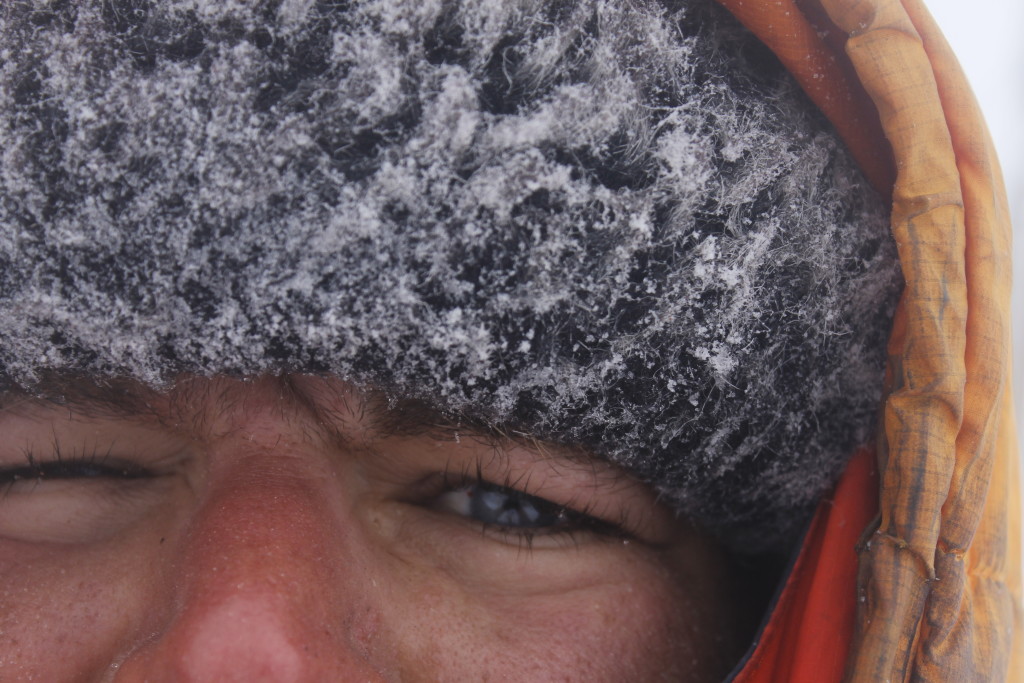
South Fork
Somewhere at the entrance of the canyon, an unseen coyote was howling, barking, howling, barking.
I skied toward it slowly, picking my way between stands of willow and alder shrub that grew in the gray flatland of the South Fork drainage. It was just after noontime. Fast moving clouds flew across the sky, allowing the sun to warm the land one instant — before they snatched the light away again. The sharp peaks in the Zirkel range to my east alternately gleamed glorious bright in full illumination or brooded in shadow like a vision out of Transylvania.
I tried not to let the weather psych me out, but it struck a harmony with my own brooding malaise.
Bear Canyon, where the coyote continued howling outrage, lay to the south in a somewhat rounder stand of mountains. It was a U-shaped gap between two ridge lines, maybe a quarter-mile across at the mouth. I couldn’t see too far up the way, but I knew that I would camp somewhere inside those walls — without a tent.
I’d sleep in a snow-shelter and rise the next morning to climb onto the ridge below The Dome. This 11,900-foot mountain, with its sheer walls, was probably out of my league, but there was an un-named sister peak, just above 11,000 feet, that had mellower topo lines on the map. I could climb it on skis, maybe.
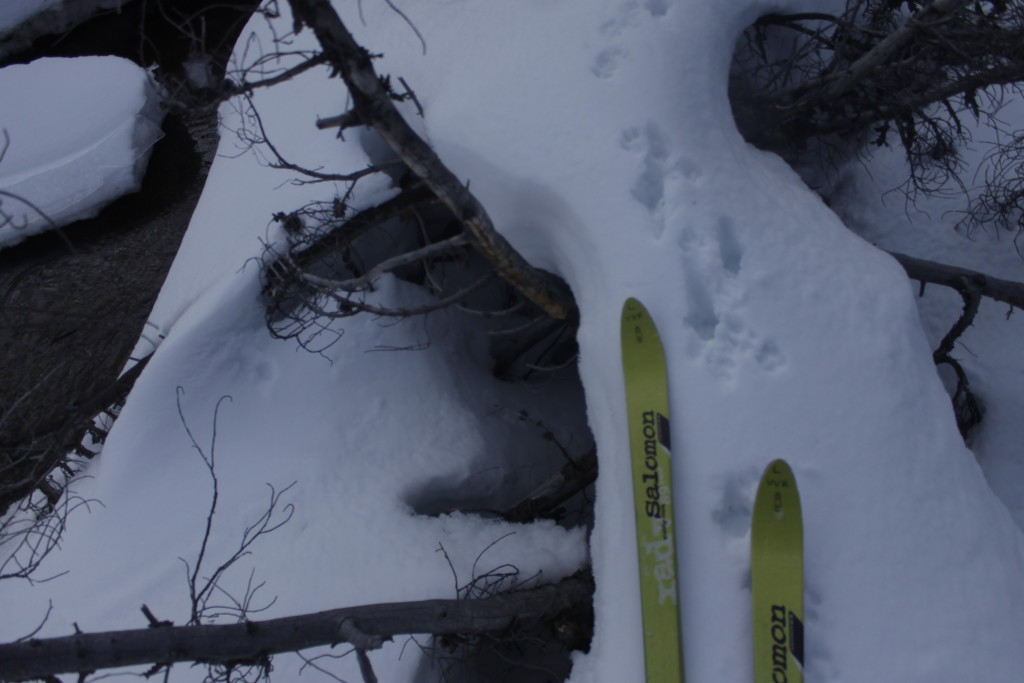
If the absent tent left an uneasy weight in my mind, I hoped the lessened weight on my back would make up for it. The pack was heavy enough with its winter sleeping bag, extra clothes, food, fuel, tarp and other miscellaneous and sundry camping items.
The abandoned tent gave me room to move a bit quicker and with less back strain (though plenty of that would come later.) There was also more responsibility when it came to setting up camp. I’m always relieved when I know I can snap a shelter together out of poles and nylon fabric in minutes. Building from nature required me to channel whatever MacGyver skills I might have. I knew that the shelter would take time, and I might make mistakes along the way. I’d have to pay attention to the elements, to work with and not in spite of them.
Not that the elements had any trouble finding challenges for me.
There was the river, for one.
I had been able to cross a couple of streams earlier in the trip by skiing over snow bridges. The South Fork offered no such convenience, just a channel of open water between me and Bear Canyon that I would have to get across somehow.
The only solution, I could see (other than taking off skis and boots and wading through barefoot) was a tree that had fallen across the current and had a layer of snow on top.
Fresh canine tracks had crossed here. The coyote was still howling outrage from somewhere in the trees, but I never saw it.
If I went too far off center, my skis would likely break the snow and drop me in the water. I set the skis at a slight angle against the log and slowly began to cross where the coyote had gone, obliterating its tracks with my own.
I reached the other side unscathed and continued toward the base of the canyon. This was north-facing territory, and thus, dominated by pines, spruce and fir. The canyon walls were scarcely visible through the thick boughs.
I stopped to eat some vegan pizza, then put the skins back on and started climbing through the forest.
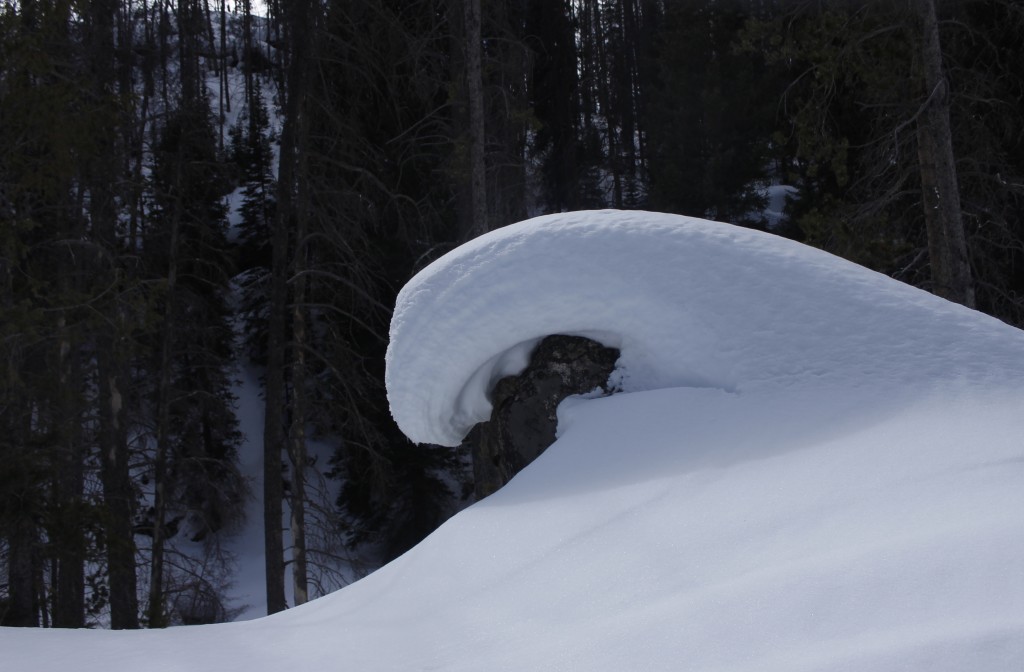
The winding climb
The clouds hid the sun again, and I found myself looking at the sameness of the trees, feeling less than inspired.
I knew that this trip had me checking off a box before the end of the season. My head wasn’t entirely in the game; it was worrying about things like career path, the descent into adulthood, my need to put down roots and build more long-term relationships with places and people. There would be laundry to do when I got back, and I would be that much further behind in filling out paperwork, making plans.
Now, I incriminated myself. How unworthy it was to be in a wild place and stand there, uninspired. Hell, real suffering hadn’t even started yet.
I’d managed to ditch five pounds of tent, but still carried several tons worth of worldly bullshit into the mountains with me. But what was I supposed to do, just cut it all loose? Pretend that the real responsibilities and questions of the world had no right to exist because, “Oooh, the mountains are so beautiful!”?
I admit that escapism is one reason why I choose to go on adventures — it’s nice to stop worrying about things because the mountains are beautiful. But nature isn’t there just to be eye candy or to plaster us with child-like wonder. It is not separate from the world we live in every day, but permeates every inch of it, from the air we breathe to the bacteria in our guts and the primal hardware that governs our wants and needs. Human nature.
The real challenge is to see sameness between that moose browsing the willows and you, online shopping; between the chittering birds and the guys shouting at each other outside a bar on Friday night.
Natural instinct is one of the reasons why many of us find hiking and camping unappealing. We are designed not to enjoy cold, exposure, vulnerability. This is in conflict with the fact that we are also designed to crave the feeling of accomplishment that comes with summiting a mountain or traveling miles of backcountry.
Walls limit the scope of our experience, whether we put them between ourselves and nature or between ourselves and other people. Taking them down also means greater risks.
Lacking a tent gave me the opportunity to have a beautiful walls-free communion with the natural world outside that night, though this came with the slight downside that the wind was picking up and it was probably going to snow. Too much exposure would get me a nice case of hypothermia.
I’d limit the exposure with a sleeping bag, tarp, and whatever I could build out of the resources I’d have in the canyon.
The more I climbed, the more dead trees I saw, a legacy of the Rocky Mountains’ pine beetle scourge. Worse, many of the trees had toppled in a recent windstorm. I found myself weaving around, doubling or tripping any straight-line distance between two points. The trees made hill climbing a special pain in the ass, because they got in the way of diagonal traverses.
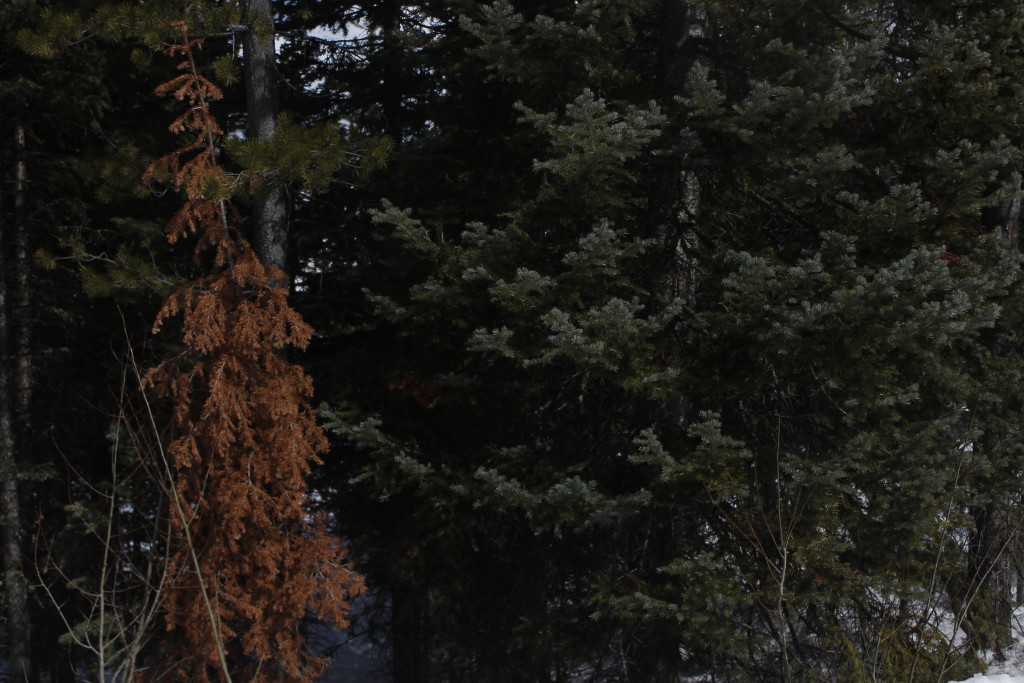
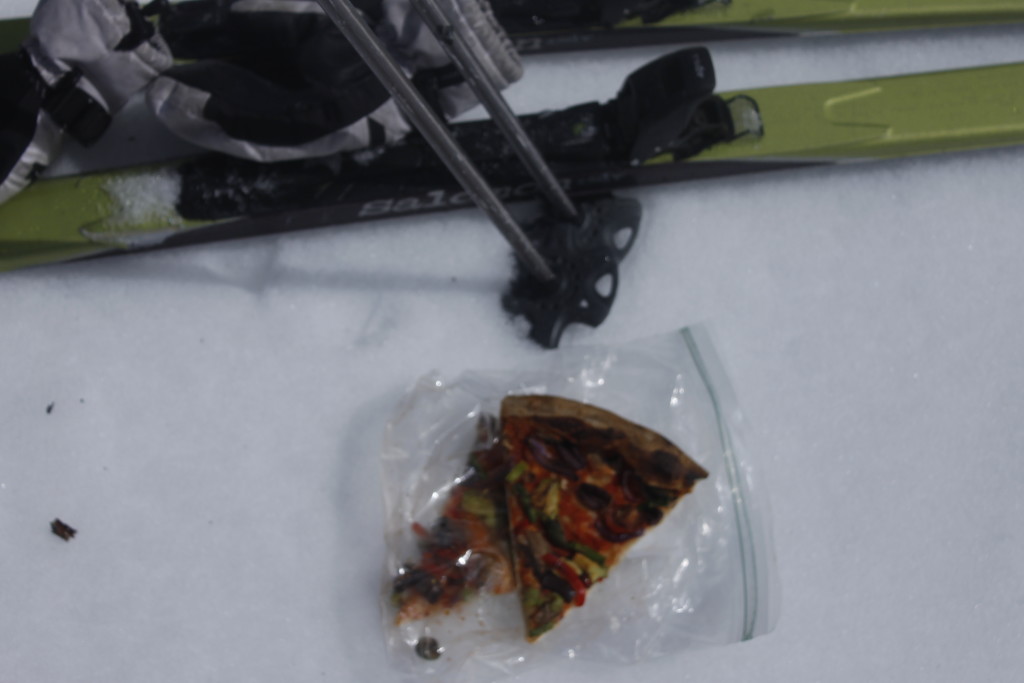
My priorities were to get shelter, water and a cook fire set up before darkness fell. Experience has taught me that it usually takes longer to do these things than I think. At around 3:15, I started the real-estate hunt.
I stopped at a couple of pines to strip away some dead red boughs (which seem to be more difficult to find at higher elevations) as fire starter. I strapped the lot of them to my pack as a home-warming present to myself.
But were there any places I wanted to settle down in this neighborhood?
Certainly, much of the west side was a no-go. I saw two places where small avalanches had left swaths of snow rubble on the bare slope. Falling snow was easy enough to avoid, but falling trees were another matter.
Almost all the trees in this part of the canyon were dead. I saw the burn marks around the trunks. I recalled that the mountains to the west of me were part of “Burn Ridge.” Yeah, there had been a burn here all right. Black skeletons of immolated pines creaked in the breeze.
The forecast called for high winds that night, leaving me none too comfortable with the idea of what thousands of pounds of falling tree trunk could do to a potential campsite. The thing was, I couldn’t find a single place outside the radius of one nasty widowmaker or another.
The sun was only a couple of degrees above the western wall. When it dropped, so would the temperature in the canyon, making camp construction that much more uncomfortable.
A time to build
The place where I threw my pack down was far from perfect as far as campsites go. There were still a couple of worrisome trees closer than what I liked. I positioned myself behind a massive burned trunk for protection.
The creek where I planned to get water was well buried in snow, requiring me to dig a five-foot hole before I could fill my cook pan with murky liquid.
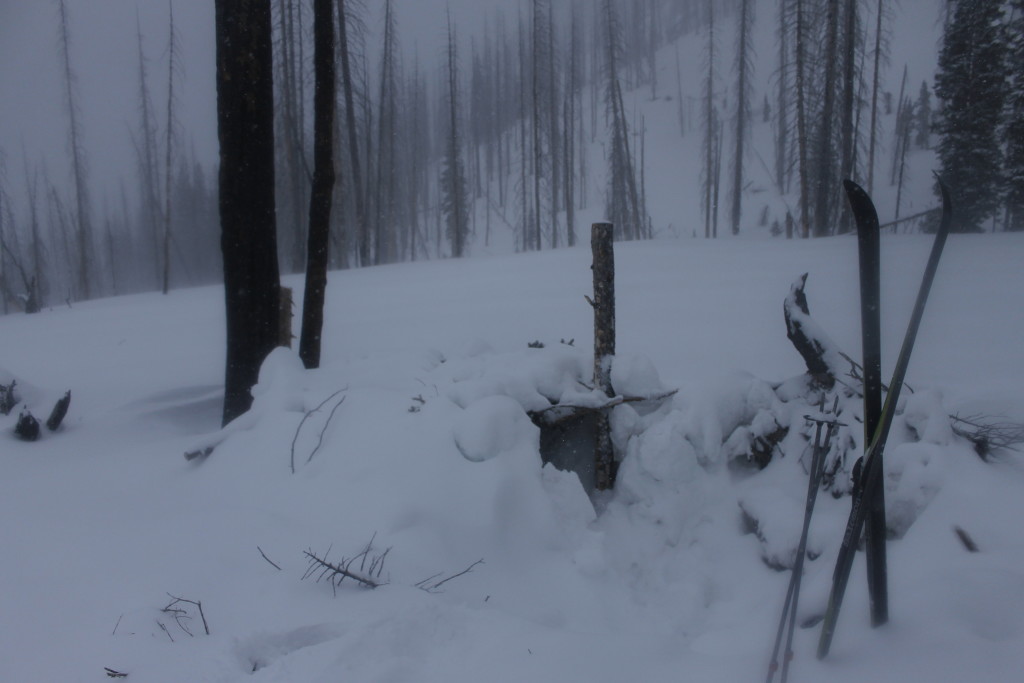
O.K., there was one life-need taken care of. Now I needed a structure to protect me from the elements.
The several feet of snow beneath my feet made for a cheap and readily available construction material. Using a snow shovel, I was able to work my way though snow crust into the compact snow, piling the rubble up onto walls on either side of the pit. I ended up with a trench that was long enough to lie down in, and about four-feet deep. Looking up was like peering out of a fresh-dug grave.
Ideally, I’d be able to use the snow to build a roof above the trench, but this was not to be. Though the snow was compact and chunky, I found that it wasn’t quite consolidated enough to dig out decent-sized snow blocks (or the more frequent, irregular snow boogers.) I did have a reflective tarp that I could use instead.
I wanted support beams for this, so it was time to do some woodwork. Fortunately, I’d packed a miniature “chainsaw” — non-motorized, unless you count the operator. There’s a toothed chain with two nylon handles that I can work around a trunk or branch like a garrote, running it back and forth to make a cut. Almost as fast as a bow saw, it made quick work of a blackened tree post, that I cut into sections. The effort helped get me warm too.
I set two long logs in an X above my snow trench, then added reinforcing girders from lighter branches. I plunged two heavy log posts into the snow at either end of the trench so that I’d have a sturdy place to hitch the tarp.*
At first, I set the tarp lengthwise, but it didn’t look long enough. I realized that I wanted to set the tarp on a diagonal with the trench so that I could have the most coverage from head to toe. I also used pine boughs and snow boogers to expand my roof slightly.
A few remaining holes kept me busy trying to secure things. Then, I remembered a trick from a book on backcountry ski camping, and dug a mini snow-cave at the end of the trench. It was just enough room for my feet and knees, but it meant that I now had plenty of room for my head to fit beneath the tarp. If I’d thought of that earlier, it would have saved time and hassle.
I set my pad and sleeping bag inside, laying them over some fresh fir boughs. The wind didn’t blow inside my trench. It was plenty comfortable, even cozy, down there.
I’d just used the elements to MacGyver myself a shelter. It gave me more pride than any tent I’d pitched.
But now it was getting dim and I had to gather more firewood, because I’d used most of the sticks I’d gathered to build the roof above the snow trench.
I dug out a kitchen area near the entrance, set three stout logs down in the snow so I had a platform to build a fire. Though the wind was blowing above me, the pit protected me from most of it.
I arranged strips of dead pine bough above a cotton ball coated in Vaseline, used a flint and steel striker to start the fire.
The warmth was welcome; the choking smoke was not.
Soon, I had a hearty blaze that I used to cook a meal of pasta and red lentils. I dried my socks on sticks near the flames. I had to shift the pot several times so it wouldn’t collapse into the fire (note that it is much easier to do these things with a pot you can hang) and got rewarded with choking draughts of smoke into my lungs. By the time I slurped down the last of the lentils, my eyes were watering, my throat was raw and I had a dull headache.
According to my watch, it had taken about four hours from when I settled on my campsite to the time that I spooned the last dinner morsel into my mouth. Time to go to bed. I felt cold dots land on my forehead. The first snowflakes were whirling down from the dark sky.
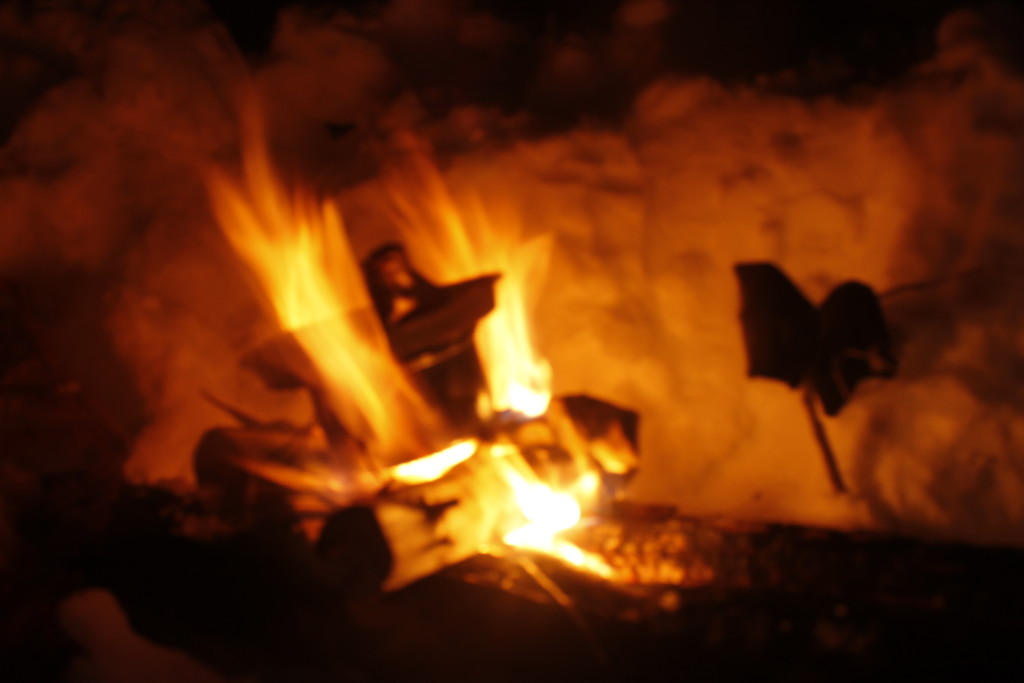
Reluctant awakenings
The sleep was good, warm and dry. I woke up late to the sound of a mean wind roaring through the canyon. It was a world I was uninterested in joining. Too bad my bladder had other plans. I struggled out of my sleeping bag and trudged a couple feet outside my shelter in whirling snowflakes to take my morning pee.
Back within the shelter, I weighed my options. Though I had thought about climbing the mountain, the wind and flakes would make for unpleasant going, not to mention the fact that a whiteout could throw off navigation. Having spent one night in the canyon, I felt that I could call the trip a semi-success before heading home.
I made my breakfast on my camp stove inside. This was a wonderful luxury, considering I wouldn’t have risked using a stove inside a flammable nylon tent and that would have meant I’d have had to cook in the blowing snow.
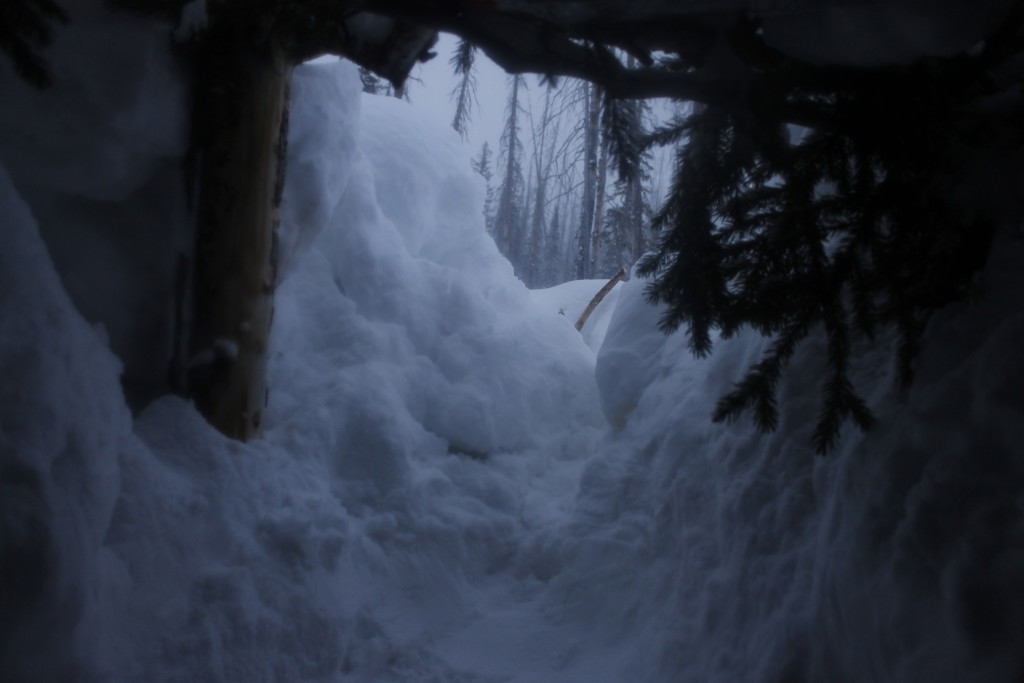
The shelter had kept most of the heavy snowfall out, but I was glad that I had put my sleeping bag into a lightweight bivy sack to keep it dry. The outside of the bag was damp, but I’d had that on tenting trips too. and it was probably moisture from my own body.
Packing up was slow trying to corral various loose items within the cramped space. Pulling away the roof was the hardest part, because after that, I had no shelter to crawl back inside.
Must go up
Backpack fully loaded, I was ready to start the return journey. Of course, the snow chose that exact moment to relent so that I could feel like a total wimp. Because of this, I started skiing up-canyon instead of back. What the hell? Maybe I could go for an hour or so before turning back, just to look around.
Within five minutes, I came to the place where I should have camped. Live pine trees made a good wind break; a gap in the snow above the creek revealed clear running water.
There was no easy way down to the current without the risk of falling in, so I tied a bottle on a string and lowered it into the current off the end of a ski pole as if fishing for water.
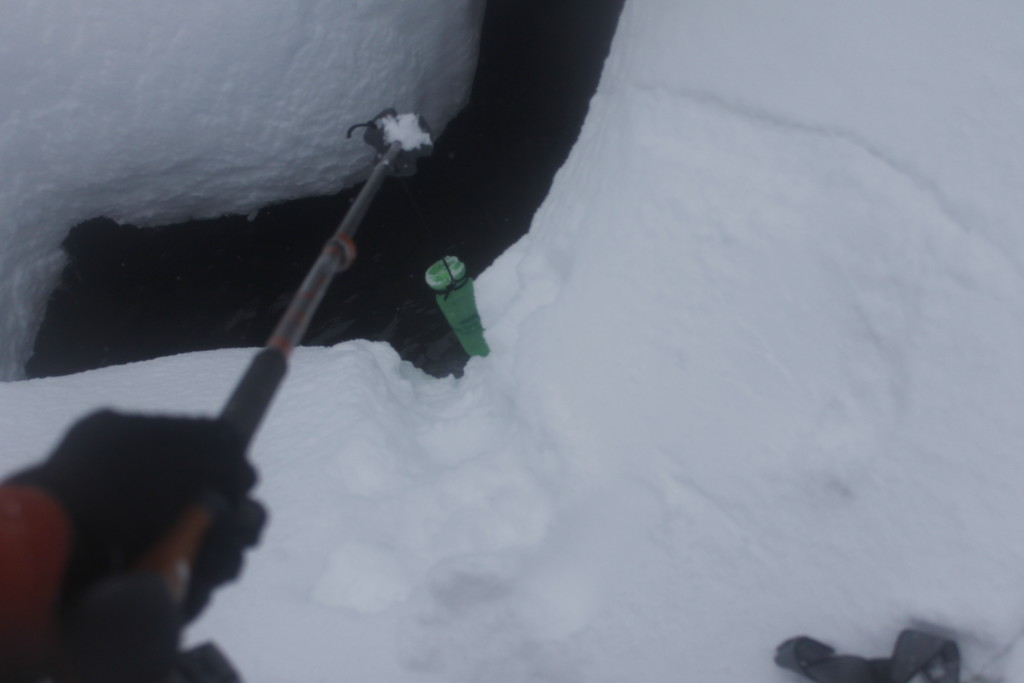
I put skins on the skis and started again. Soon the storm was back at full bore. The howling wind made me nervous about falling trees. I kept glancing over my shoulder, half-expecting to see a tree trunk flying down at me like a death angel.
Moving was slow and harder work then it had been skimming above the crust a day earlier. But the fresh snow was good news too, because it meant that there would be ample powder to carve on the decent.
The climb steepened, forcing me to make several switchbacks. Looking into the wind was coldest, but I preferred it to having the wind at my back, where I wouldn’t be able to see which way a falling tree was coming.
The western sky was a dark mass of snow and menace. I watched the darkness grow, felt the wind rise. Soon sharp flakes whipped all around and the world went over to fading grades of white. Maybe the top of that ridge was the place to turn around, I thought. By the time I got there, the snow had let up somewhat, though I could see another blast bearing down from the west.
Well exposed
There was another ridge higher up, and I decided that since I had come this far, I might as well go to the next one.
I skied toward an overlook above a 1,000-foot bowl. A lonely pillar of burnt pine gave me a place to put my back to the wind and chew a chocolate bar in relative shelter. Wind and flakes flew past me and over the gulf. The sharp columns and rock flutings of Big Agnes and the Zirkels stood jagged, half-visible on the other side. Snow streamers blew off the ridges like chimney smoke, leaving white imprints against the dark sky.
The storm showed a side of the mountains’ nature that’s harder to grasp on those perfect sunny days. The high peaks defied the winds ravaging their slopes, but also fed them, glorying in the chaos. It was a violent ritual, but nonetheless, necessary to affirm what the mountains were.
My stubborn ascent, the night in the snow trench, were another kind of affirmation ritual. I needed to prove that I was tough for evidence against the times when I was not tough. I needed to show that there was a place for me in these mountains, even when my instincts sought the routine and comforts of home life. Now, I saw that the blasted mountain range across the gulf, with its tough, unfeeling rock columns, was far more confident in its position than I could be.
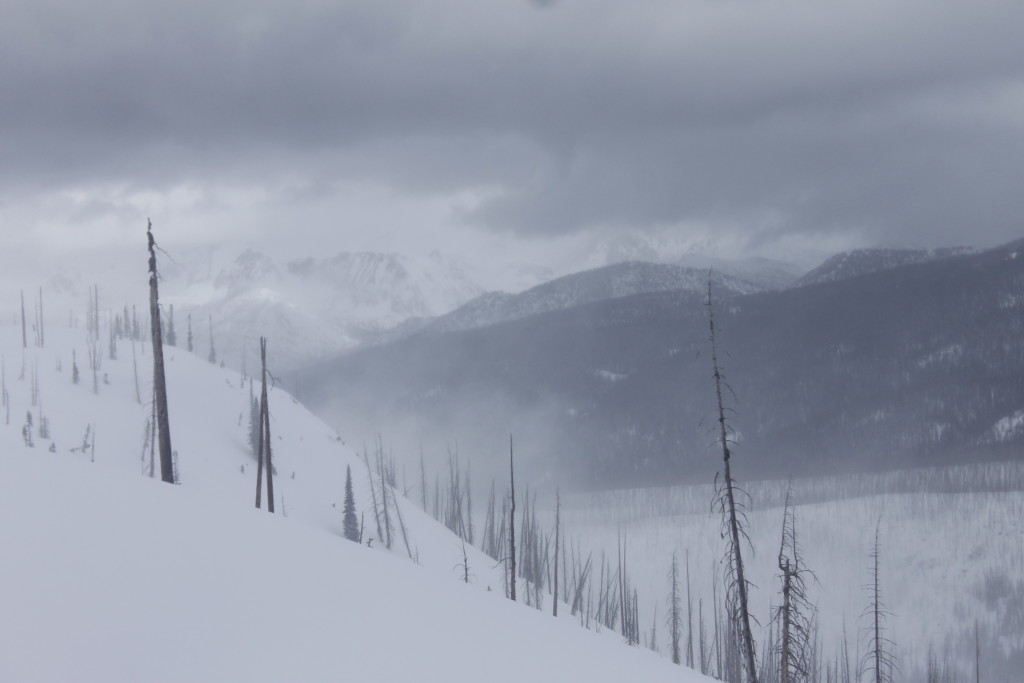
I had sought exposure in nature as a means to enlighten myself. Now, the mountain ridge looked very exposed indeed. The light was treacherous.
More than once, I wandered into a snowbank, because I couldn’t distinguish it from the rest of the white snow. The mountains, practically lost in the white of whirling flakes, looked just like what happens when I set my camera’s shutter speed too slow. It was getting harder to tell things apart and set a course.
This overexposed world required a smaller aperture. I needed to close up, narrow my focus to the foreground elements and put one ski in front of the other.
I skied out from behind the tree trunk, intending to turn around. Instead, I found myself skiing along the ridge, then continuing up toward the unseen summit. Switchback after switchback, I climbed furiously.
2 p.m. was my hard turn around time. Get to the top of this damn thing, I thought. It would remain to be seen if there would be time to ski back home before evening. It was possible I might just hole up in a forest service outhouse for the night.
Finally, I topped out on a broad ridge, where I would have to go down before I went back up again. The dark bulk of The Dome rose out of the veils of snow. Forbidding rock faces frowned down at the land below. Even if there were time, it didn’t look like anything I wanted to try without technical equipment and more experience.
I had, however, climbed the topo lines to the unnamed black dot on the map that I had set out for. The whole trip had built up toward a couple of brief blasted visions of distant peaks. I could weigh whether I’d learned anything later. It was time to go back.
I peeled the skins off the ski bottoms and pointed the boards downhill.
The fresh snow was great for skiing. I weaved through the burned trees with a series of juicy telemark turns, covering distances that had taken me 20 minutes worth of climbing in two minutes. The wind had mostly obliterated my old tracks, so I navigated by going downhill and to the northwest, checking my compass periodically. The snow kicked up and washed out my view of mountains or any other landmarks I could have used to navigate.
At one ridge, I found myself looking down a gulf to my right and to my left, unsure which was the one I’d come up from because I didn’t know where I was standing.
By dumb luck, I saw a ghost imprint of my old tracks going toward the western valley and went that way.
I switched from bold telemark turns to slower, zigging kick turns as the terrain steepened. Wind had shaped the powder into unpredictable formations. One moment I’d be crawling through shin-deep snow, the next, I could be rocketing over bare crust. It was impossible to know what the snow ahead was like until I was already skiing over it.
As I went deeper into the canyon, the wind started to relent.
I noticed a familiar clearing, then saw the place where I had refilled my water bottles in the stream when I’d set out that morning.
I filled them once more. There were hours of skiing left before I got back home over tricky terrain and uneven snowmobile trails. It was a relief to know where I stood.
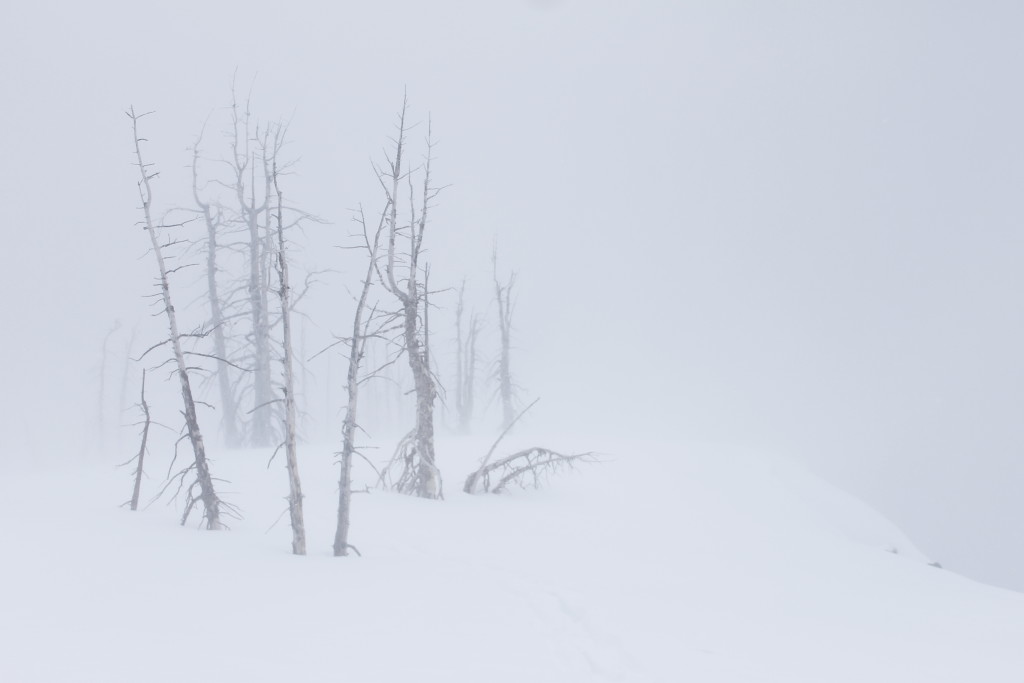
*(Footnote regarding shelter construction)
I probably reinforced the tarp more than I needed to. Because I left it flat, that meant that I needed to bring more lumber than if I had built a pitched roof, which could have shed snow weight via gravity. One downside to the alternative method was that it would require me to settle for a smaller roof. The fact that I weighted the tarp made it less susceptible to the vagaries of wind.
